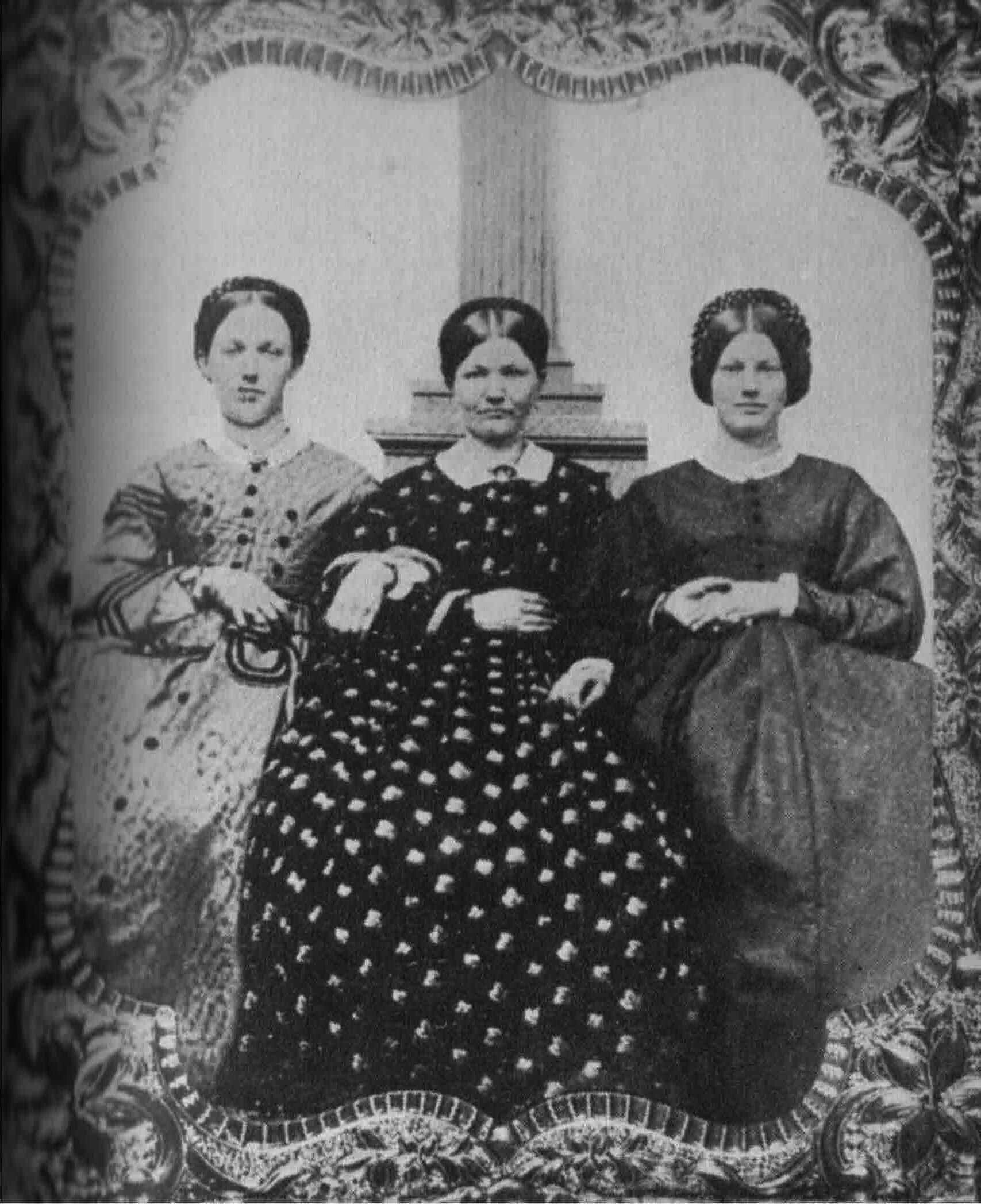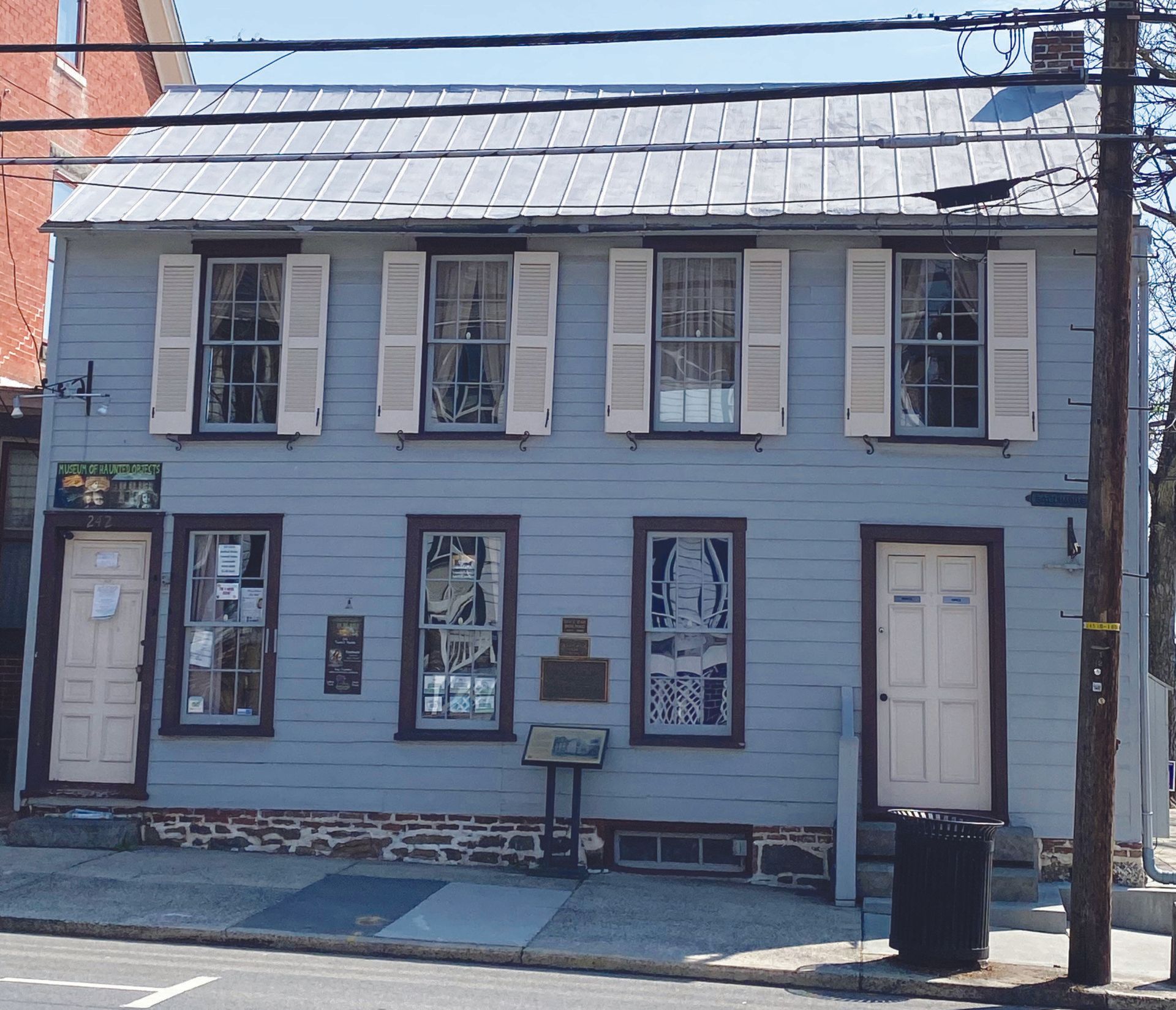Mary Virginia “Jennie” Wade, age 20, was killed outright on the morning of the third day as she mixed dough for biscuits to feed the hungry Union soldiers.
About 170,000 soldiers converged on the town of about 2,400 during the first three days of July in 1863. The men who fought at Gettysburg all needed nourishment and drink, especially with the hard fighting, long marches, and working in the sultry summer heat.
The reason Jennie Wade is remembered by so many is that she gave up her life as she attempted to serve the Union soldiers – and therefore her country.
Jennie Wade was the second daughter born to James and Mary Wade on May 21, 1843. Her sister, Georgia, was almost two years older, having been born on July 4, 1841. Another daughter, who died in infancy, and three brothers followed: John, Sam, and Harry.1
Jennie was born in a two-story Federal style clapboard home, located on the corner of Baltimore Street and Wade Avenue. The family rented the house, and James Wade, a tailor, used a portion of the building for his business. The Wade women assisted James, and all became expert seamstresses.2
Within a few years, the family built a home on the corner of Breckinridge and Washington Streets.
When Jennie was just seven years old, her father was arrested for larceny and convicted to spend two years in prison. His time in jail must have worsened him, for Mary Wade later appeared in court to have him declared insane. Mr. Wade was sent to the Alms House, a place for the destitute and mentally ill that was located north of town, near the future part of the battlefield known as Barlow’s Knoll.3
The conviction of Mr. Wade brought shame to the family and thrust them into poverty. Jennie and Georgia labored with their mother as seamstresses to bring in enough money for them to subsist and feed a family of six. The boys, too, rented themselves out for labor. Young Sam soon apprenticed for James Pierce, a prominent butcher who lived just one block from their home. Since Gettysburg was a thriving crossroads town, there were several carriage-making businesses. Jennie and Georgia often helped with the creation and mending of carriage tops. Jennie met her close friend, and later beau, Johnston “Jack” Skelly, who also worked at times with the carriage companies, but was also a stone cutter. Another childhood friend, John Wesley Culp, worked as a tailor. As the carriage business fell off, Culp’s employer, William Hoffman, moved his business to Shepherdstown, Virginia (now West Virginia). Culp went with him in 1856, just five years before the war erupted. One of Jack Skelly’s brothers, Edwin, also moved to Virginia with Mr. Hoffman.4
When the war came, Edwin Skelly returned to fight for the Union. Jack also enlisted. Wesley Culp remained in Virginia, and joined the Confederacy – much to the chagrin of his family and the populace of Gettysburg.
Jack, who was two years older than Jennie, was twenty years old when he enlisted. He corresponded regularly with his childhood friend, and she began to look forward to his correspondence. During the first two years of the war, the couple’s friendship began to blossom. While there is no proof of an engagement, it was clear that Jack and Jennie were more than friends.
In the midst of the war, Georgia married her sweetheart, John Louis McClellan. Mr. McClellan was the son of John McClellan, the owner of what is now The Gettysburg Hotel. He was well known, and liked, in the town. A bachelor, Mr. McClellan never married John Louis’s mother; the public seemed to look the other way at this indiscretion.5
Jennie was needed even more by her mother to help with work, as Georgia soon became pregnant. The mother-to-be lived nearby in a rented home at the top of the hill on Baltimore Street, while her husband was absent fighting for the Union.
Jennie showed ardent patriotism. In addition to supporting her beloved Jack, her oldest brother, John, also joined the Union army when he was old enough to enlist, shortly before the Battle of Gettysburg in 1863.6
When General Buford’s Division rode down Washington Street, past Jennie’s home, many of the girls of the town stood in a line, singing patriotic songs and passing out water, flowers, and bread. Jennie was unable to join them as she worked fastidiously on her brother’s uniform to alter it to fit him. The next day, July 1, the battle began in earnest west of town.
Jennie felt uncomfortable living in her clapboard home on Breckinridge Street. Her sister, Georgia, had given birth to a son, Louis Kenneth McClellan on June 26th, the day the Confederates first invaded the town. The baby has been named “ the youngest veteran of the Battle of Gettysburg”.7
On the same day, there was an altercation between the Confederate troops and young Sam Wade, age eleven. Mr. Wade, knowing that the invaders would confiscate their horses, sent Sam away with their prized mare. Men in gray captured both the horse and Sam; they threatened to take Sam as a prisoner of war. Mr. and Mrs. Wade pleaded for them to leave the boy, and from her house a block away, Jennie saw the scene.8
Tillie Pierce recalled that Jennie “was standing a short distance off ” and “screamed at the top of her voice…’If the Rebs take our Sam, I don’t know what I’ll do with you folks!’” Tillie was aghast that Jennie would hold the Pierces responsible when it was clear they could not control the outcome of the situation. Thankfully, the Confederate officer returned Sam Wade to his family, and he went to Georgia’s house up the street.9
With her sister indisposed, Jennie cooked and cleaned while her mother helped with the baby. On July 2, the battle raged nearby and a shell struck the house. Fortunately, no one was hurt, but a hole was torn in the plaster wall that separated Georgia’s side of the house with the neighbors who rented the other side.10
When she could, Jennie filled a pail of water and took it to the troops who were marching to their deployment. Many soldier accounts record the young woman who gave them biscuits and water, which they greatly appreciated.11
The Jennie Wade birthplace
(Author Photo)
On the evening of July 2, Annie Culp Myers, who lived with her husband on Middle Street, heard a knock at the door. Opening it, she was overjoyed to see her brother, Wesley. Sporting the gray Confederate uniform, Wes served with the 2nd Virginia Infantry, part of the famous Stonewall Brigade. He slipped away from his post to see his sisters, Annie and Julia. He mentioned seeing Jack Skelly in Winchester, Virginia, badly wounded in his arm. Private Culp told his sister that Jack gave him a message for Mrs. Skelly but he didn’t find her at home. When Annie asked to hear the message, Wesley was circumspect and said only Jack’s mother could know. The following morning, shortly after dawn on Culp’s Hill, Wesley Culp was killed. 12
The bombardment of artillery and musketry on Culp’s Hill at first light on July 3, 1863 must have woken Jennie and the rest of the inhabitants of the house. At about 8 a.m., Jennie went to the kitchen and began making dough for biscuits to feed the Union soldiers.
It is not known who fired upon the house, or if the house was even a target. From somewhere north of the McClellan house on Baltimore Street, a soldier fired his musket and the bullet penetrated the outer door, then pierced the inner door leading to the kitchen and slammed into Jennie Wade. The bullet found its mark in her heart, and she fell dead without a sound.
Mrs. Wade saw her daughter fall and exclaimed, “ Georgia, your sister is dead.” 13
A few Union soldiers helped Mrs. Wade, Georgia, and the boys, including the newborn child, to the cellar. Jennie’s mother insisted that Jennie be brought along as well. Wrapped in a quilt, Jennie’s body was carried by a soldier across the gap in the wall made by the artillery shell the previous day. They waited in the cellar the rest of July 3.
On Saturday, July 4, the battle had ended. It was a rainy Independence Day, and Georgia’s birthday. The family procured a coffin and buried Jennie in the yard, with her apron containing a photograph of Jack Skelly and with flour and dough sticking to her hands.
The grave of Jennie Wade was eventually moved to Evergreen Cemetery. In 1901, a tombstone was dedicated with funds raised by the Iowa Women’s Relief Corps – of which Georgia McClellan was a member. A few years later, a flagpole supporting Old Glory was placed beside the grave. The flag flies over it day and night. The Women’s Relief Corps sends two flags each year for the grave. 14
Jennie’s last words had been, “ If there is anyone in this house that is to be killed today, I hope it is me, as George has that little baby.” Her utterance proved, sadly, prophetic. 15
Jack Skelly succumbed to his wounds about two weeks after Jennie died. The three childhood friends were spared the sorrow of losing each other.
Regardless of her early fate, Jennie’s short and difficult life demonstrated kindness and patriotism. She risked, and lost, her life because she wanted to help the soldiers battling for her town and her nation. As we remember her birthday from the spring of 1843, we also remember one taken far too soon, like so many who fought at the Battle of Gettysburg and beyond.
Sources: Alleman, Tillie Pierce. At Gettysburg: Or What a Girl Saw and Heard of the Battle . New York: W. Lake Borland, 1889 (reprint: Gettysburg, PA: The Shriver House, 2005). Culp, Wesley, Personal Accounts File, Gettysburg National Military Park. The John W. Johnston Account, Jennie Wade File, Adams County Historical Society (hereafter ACHS). Kennell, Brian A. Beyond the Gatehouse: Gettysburg’s Evergreen Cemetery . Gettysburg, PA: The Evergreen Cemetery Association, 2000. Louis McClellan Obituary, The Gettysburg Times, February 13, 1941. U.S. Census, 1860 and 1870, Cumberland Township, PA, Ancestry.com . Skelly Family File, ACHS.
The McClellan home, where Jennie was killed
(Author photo)
End Notes:
1. Johnston Account, Jennie Wade File, ACHS.
2. The Wade house, the only white house on the corner of Washington and Breckinridge Streets, still stands. It is privately owned.
3. U.S. Census, 1860, 1870. The Alms House no longer stands.
4. Wesley Culp File, GNMP. Skelly Family File, ACHS.
5. Kennell, p. 21.
6. Johnston Account, Jennie Wade File, ACHS.
7. The Gettysburg Times, Feb. 13, 1941.
8. Alleman, p. 24.
9. Ibid., pp. 24-25.
10. The opening made by the shell is still intact and easily seen at the house where Jennie was killed.
11. Johnston Account, Jennie Wade File, ACHS.
12. Wesley Culp File, GNMP.
13. Johnston Account, Jennie Wade File, ACHS.
14. Kennell, p. 52. The grave was, for a time, in a local churchyard before being moved to Evergreen.
15. Johnston Account, Jennie Wade File, ACHS.
Author's Note: Louis K. McClellan was not the only newborn at the Battle of Gettysburg. David McConaughy's daughter also gave birth shortly before the battle.






